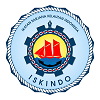Studi Karakteristik Massa Air Pada Lapisan Termoklin Di Selat Makassar
Abstract
ABSTRAK
Selat Makassar merupakan jalur strategis antara Kalimantan dan Sulawesi yang menghubungkan Samudera Pasifik dan Samudera Hindia. Selain menjadi rute pelayaran internasional penting, wilayah ini juga rawan terhadap ancaman keamanan seperti ranjau laut dan drone bawah air, sehingga membutuhkan pengawasan ketat dan kerja sama lintas sektor. Penelitian ini bertujuan untuk mengeksplorasi karakteristik kolom air, khususnya lapisan termoklin yang berpotensi menjadi wilayah persembunyian (Shadowzone), pada kedalaman 0–300 meter di choke point Selat Makassar. Data suhu dan salinitas terhadap kedalaman diperoleh dari pengukuran argo float selama periode Oktober 2017 hingga Januari 2018. Perhitungan kecepatan rambat suara dilakukan menggunakan persamaan empiris Medwin. Lapisan termoklin diidentifikasi melalui gradien suhu sebesar 0,1°C per meter. Visualisasi dan analisis data dilakukan menggunakan perangkat lunak ODV 5.6.2. Hasil penelitian menunjukkan bahwa lapisan termoklin berada pada kedalaman 86,4–158,1 meter, dengan suhu 16,79–27,98°C, salinitas 33,75–34,67‰, dan kecepatan suara 1514,19–1541,95 m/s. Ketebalan lapisan sekitar 72 meter ini diindikasikan sebagai Shadowzone yang potensial menjadi lokasi persembunyian objek bawah laut.
Kata Kunci: Selat Makassar, Lapisan termoklin, Suhu, Salinitas, Kecepatan Suara
ABSTRACT
The Makassar Strait is a strategic route between Kalimantan and Sulawesi that connects the Pacific Ocean and the Indian Ocean. In addition to being an important international shipping route, this area is also prone to security threats such as sea mines and underwater drones, requiring strict surveillance and cross-sector cooperation. This study aims to explore the characteristics of the water column, particularly the thermocline layer that has the potential to become a hiding place (Shadowzone), at a depth of 0–300 metres at the Makassar Strait choke point. Temperature and salinity data at different depths were obtained from argofloat measurements during the period from October 2017 to January 2018. Sound propagation velocity calculations were performed using the Medwin empirical equation. The thermocline layer was identified through a temperature gradient of 0.1°C per metre. Data visualisation and analysis were conducted using ODV 5.6.2 software. The results of the study show that the thermocline layer is located at a depth of 86.4–158.1 metres, with a temperature of 16.79–27.98°C, salinity of 33.75–34.67‰, and sound velocity of 1514.19–1541.95 m/s. The thickness of this layer, approximately 72 metres, is indicated as a potential shadow zone for the hiding of underwater objects.
Keywords: Makassar Strait, Thermocline Layer, Temperature, Salinity, Sound Velocity
Full Text:
PDF (Bahasa Indonesia)References
Agustinus. (2016). Studi karakteristik massa air untuk menentukan shadow zone di Selat Makassar. Jurnal Chart Datum, 2(2), 69–78. https://doi.org/10.37875/chartdatum.v2i2.43
Agustinus, Pranowo, W. S., Nurhidayat, N., Asmoro, N. W., & Hendra. (2022). Karakteristik suhu dan salinitas di Selat Makassar berdasarkan data CTD cruise Arlindo 2005 dan Timit 2015. Jurnal Chart Datum, 8(2), 107–116. https://doi.org/10.37875/chartdatum.v8i2.144
Agustinus, Pranowo, W. S., Manik, H. M., Rahmatullah, A., & Aji, T. (2023). Relationship between water mass characteristics to sound velocity profiler (SVP) from South China Sea and Indonesian Throughflow Currents in Sulawesi Sea. Depik Jurnal Ilmu-Ilmu Perairan, Pesisir dan Perikanan, 12(3), 346–353. https://doi.org/10.13170/depik.12.3.27560
Andrianto, A. (2002). Propagasi akustik di bawah laut dengan menggunakan metode ray tracing [Tugas akhir, Institut Teknologi Bandung]. Repositori ITB.
Boston, N. J. E. (1966). Objective definition of the thermocline (Technical Report). Department of Oceanography, Texas A&M University.
Gordon, A. L. (2005). Oceanography of the Indonesian seas and their throughflow. Oceanography, 18(4), 14–27. https://doi.org/10.5670/oceanog.2005.01
Gordon, A. L., & Fine, R. A. (1996). Pathways of water between the Pacific and Indian oceans in the Indonesian seas. Nature, 379(6561), 146–149. https://doi.org/10.1038/379146a0
Gordon, A. L., Sprintall, J., Van Aken, H. M., Susanto, D., Wijffels, S., Molcard, R., Field, A., Pranowo, W., & Wirasantosa, S. (2010). The Indonesian throughflow during 2004–2006 as observed by the INSTANT program. Dynamics of Atmospheres and Oceans, 50(2), 115–128. https://doi.org/10.1016/j.dynatmoce.2009.12.002
Hasse, L., & Dobson, F. (1986). Introductory physics of the atmosphere and ocean. D. Reidel Publishing Company. https://doi.org/10.1007/978-94-009-4450-1
Hasanudin, M. (1998). Arus lintas Indonesia (ARLINDO). Jurnal Oseana, 23(2), 1–9.
Ilahude, A. G., & Gordon, A. L. (1996). Thermocline stratification within the Indonesian seas. Journal of Geophysical Research: Oceans, 101(C5), 12401–12409. https://doi.org/10.1029/95JC03798
Khanan, M., & Ashari, A. (2020). Pengukuran kecepatan suara dalam media air menggunakan sensor ultrasonik. Indonesian Journal of Electronics and Instrumentation Systems (IJEIS), 10(1), 75–86. https://doi.org/10.22146/ijeis.51739
Li, X., Colon, P. C., & Friedman, K. S. (2000). Estimating oceanic mixed layer depth from internal wave evolution observed from RADARSAT-1 SAR. Johns Hopkins APL Technical Digest, 21(1), 130–135.
Medwin, H. (1975). Speed of sound in water: A simple equation for realistic parameters. The Journal of the Acoustical Society of America, 58(6), 1318–1319. https://doi.org/10.1121/1.380790
Putra, T. W. L., Kunarso, K., & Kusumaningtyas, A. R. T. D. (2020). Distribusi suhu, salinitas dan densitas di lapisan homogen dan termoklin perairan Selat Makassar. Indonesian Journal of Oceanography, 2(2), 123–132. https://doi.org/10.14710/ijoce.v2i2.7890
Ross, D. A. (1970). Introduction to oceanography. Appleton-Century-Crofts.
Santoso, S. P., IP, S., Sidjabat, C. A., IR, B., & Han, M. (2021). Power negara. Deepublish.
Schlitzer, R. (2022). Ocean Data View (Version 5.6.5) [Computer software]. Alfred Wegener Institute. https://odv.awi.de/
Sidabutar, H. C., Rifai, A., & Indrayanti, E. (2014). Kajian lapisan termoklin di perairan utara Jayapura. Journal of Oceanography, 3(2), 135–141. https://doi.org/10.14710/joc.v3i2.4746
Suhana, M. P. (2018). Karakteristik massa air dan struktur termohalin di perairan timur Sulawesi Utara. Jurnal Ilmu Kelautan Tropis, 10(1), 123–135. https://doi.org/10.29244/jitkt.v10i1.19581
Suharyo, O. S., Adrianto, D., & Hidayah, Z. (2018). Pengaruh pergerakan massa air dan distribusi parameter temperatur, salinitas dan kecepatan suara. Jurnal Kelautan: Indonesian Journal of Marine Science and Technology, 11(2), 104–112. https://doi.org/10.21107/jk.v11i2.4521
Tomczak, M., & Godfrey, J. S. (2001). Regional oceanography: An introduction (2nd ed.). Pergamon Press. https://doi.org/10.1016/B978-0-08-041021-0.50003-4
Urick, R. J. (1983). Principles of underwater sound (3rd ed.). Peninsula Publishing.
Wahyudi, A. (2006). Propagasi akustik bawah air untuk navigasi dan komunikasi kapal selam TNI AL di perairan Selat Makassar [Tugas akhir, Sekolah Tinggi Teknologi Angkatan Laut]. Repositori STTAL.
Wijaya, R., Setiawan, F., & Fitriani, S. D. (2011, November). Kajian fenomena Arlindo di Laut Seram dan kaitannya dengan perubahan iklim global. In Seminar Internasional Kelautan, Denpasar, Bali.
Winanta, J., Kuswardani, A. R. T. D., Setiadi, H., & Riyadi, N. (2022). Studi lapisan termoklin untuk menentukan pola perambatan gelombang suara. Jurnal Chart Datum, 1(2), 143–150. https://doi.org/10.37875/chartdatum.v1i2.112
DOI: https://doi.org/10.21107/jk.v18i2.29829
Refbacks
- There are currently no refbacks.

This work is licensed under a Creative Commons Attribution 4.0 International License.

Jurnal Kelautan by Program Studi Ilmu Kelautan is licensed under a Creative Commons Attribution 4.0 International License.
Published by: Department of Marine Sciences, Trunojoyo University of Madura













